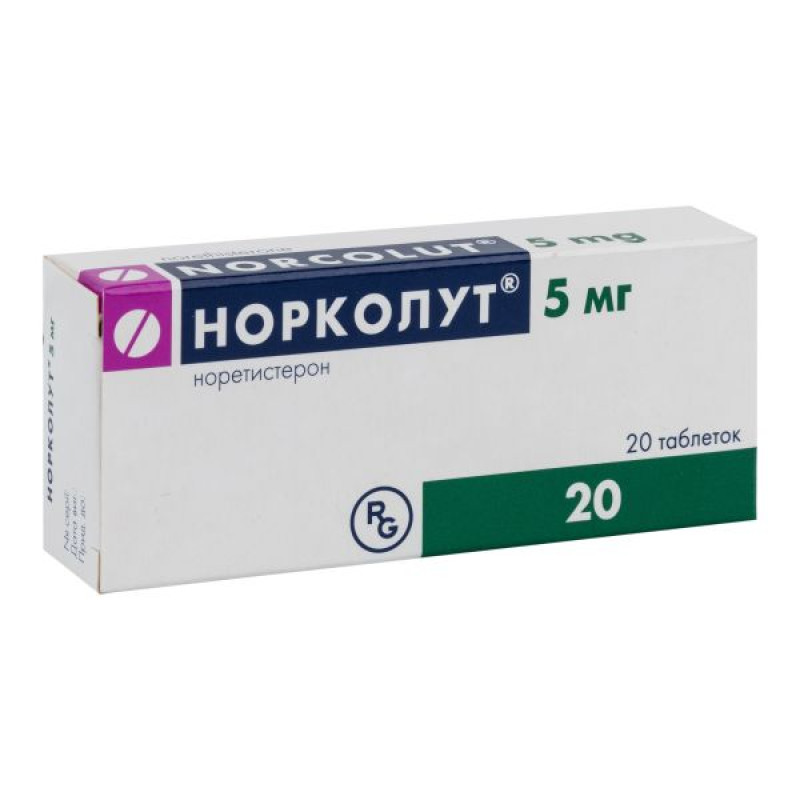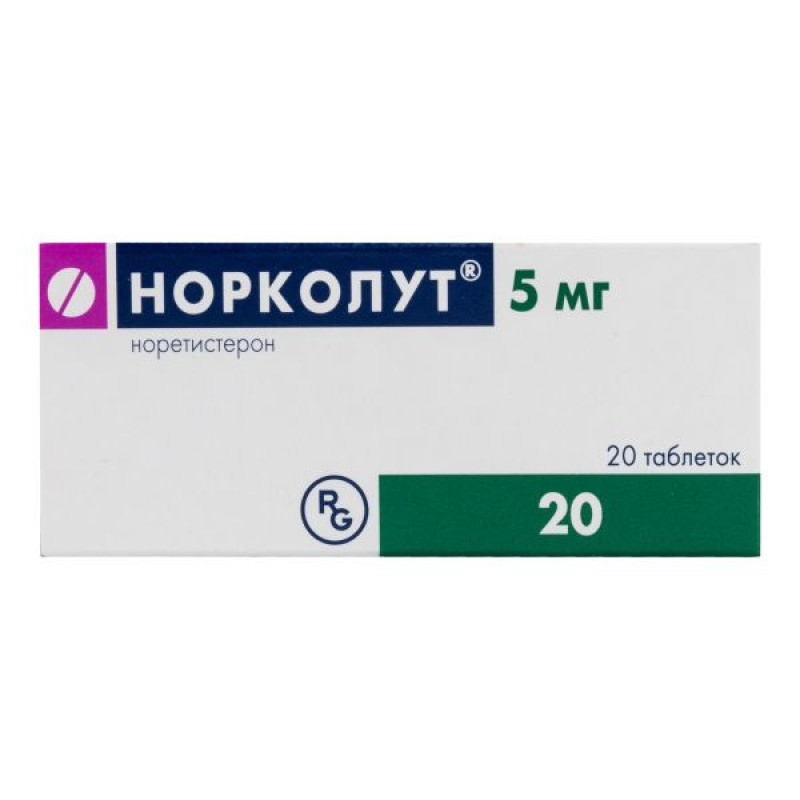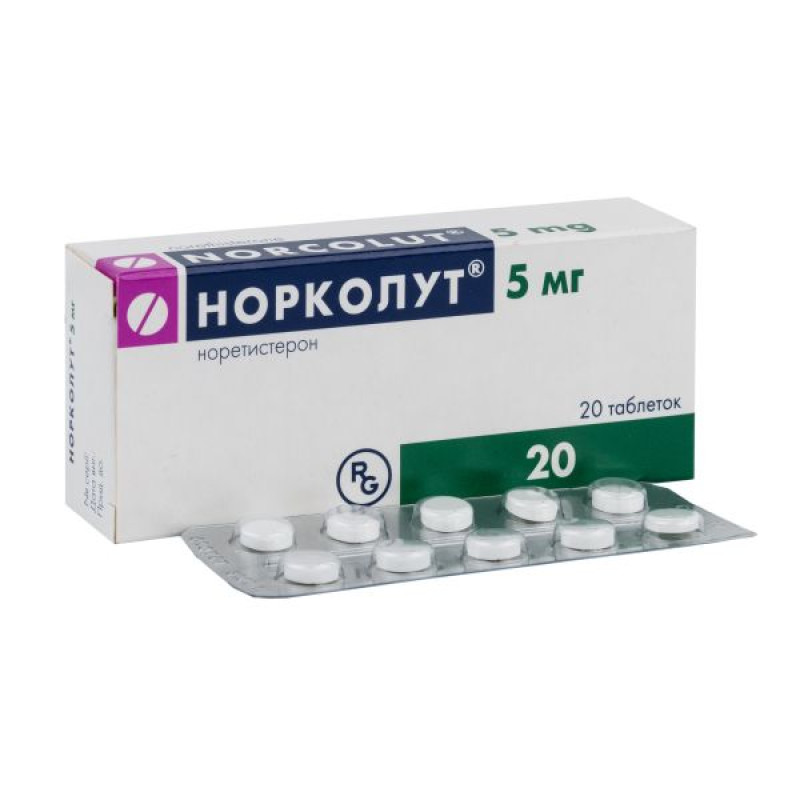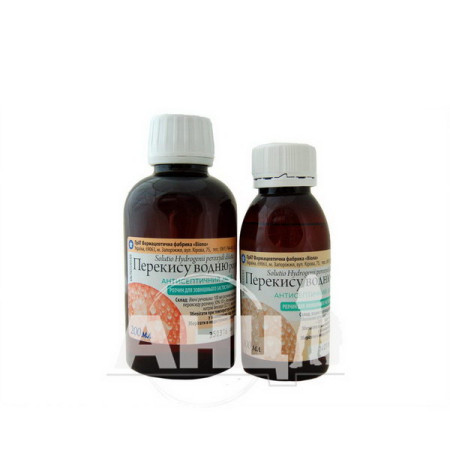Norcolut tablets 5 mg blister No. 20

Instructions Norcolut tablets 5 mg blister No. 20
Composition
active ingredient: norethisterone; 17α-ethynyl-17β-oxy-4-estren-3-one;
1 tablet contains 5 mg of norethisterone;
excipients: potato starch, magnesium stearate, colloidal anhydrous silicon dioxide, gelatin, talc, corn starch, lactose monohydrate.
Dosage form
Pills.
Main physicochemical properties: flat round tablets of white or almost white color with a bevel, on one side of the tablet - marking "NORCOLUT", on the other - "+", diameter: about 8 mm.
Pharmacotherapeutic group
Hormones of the sex glands and drugs used in pathologies of the genital area. Progestogens. ATX code G03D C02.
Pharmacological properties
Pharmacodynamics
Norethisterone is a progestogen. It causes secretory changes in the proliferating endometrium and blocks gonadotropin secretion in the pituitary gland, preventing follicle maturation and ovulation.
Pharmacokinetics
Absorption
It is well absorbed from the gastrointestinal tract. As a result of intensive primary metabolism in the liver and intestinal wall, bioavailability is 50-77%.
Distribution
After taking 0.5 mg or 1 mg or 3 mg of norethisterone, the maximum plasma concentration is 2-5 ng/ml, or 5-10 ng/ml, or 30 ng/ml, respectively, when measured 0.5-4 hours after taking the drug. When prescribed in combination with ethinylestradiol, an increase in the concentration of the drug in the blood plasma is possible, which increases with repeated administration until an equilibrium state is reached. This is mainly due to the binding of norethisterone to sex hormone binding globulin (SHBG) and a slowdown in its metabolism.
Biotransformation
Among the metabolites of norethisterone, there are many isomers, for example, 5α-dihydro-norethisterone and tetrahydro-norethisterone, which are excreted in the urine as glucuronide conjugates. Some of norethisterone and its metabolites form a bond with the 17β-hydroxy group.
Elimination
The decrease in norethisterone serum concentration occurs in two phases. The half-life in the first phase is 2.5 hours, in the final phase - 8 hours. 80% of the metabolites formed in the liver are excreted in the urine.
Indication
Secondary amenorrhea, endometriosis.
Contraindication
Norcolut® should not be used if you have any of the conditions or diseases listed below.
Pregnancy or suspected pregnancy. Breastfeeding. Formation of a blood clot in the veins (thrombosis), for example in the blood vessels of the legs (deep vein thrombosis) or lungs (pulmonary embolism). High risk of venous or arterial thrombosis. Conditions that precede thrombosis (including transient ischemic attack, angina pectoris) now or in history. History of migraine with focal neurological symptoms. Diseases associated with impaired blood circulation in the arteries, such as myocardial infarction or stroke, now or in the past. Diabetes mellitus with vascular complications. Severe liver disease now or in the past, until liver function tests return to normal. Symptoms of liver disease may include, for example, yellowing of the skin and/or itching of the whole body. Dubin-Johnson syndrome, Rotor syndrome, as well as jaundice or cases of severe skin itching during previous pregnancies. Previous cases of pemphigoid gestationis (herpes gestationis). Benign or malignant liver tumors, present or in the past. Malignant tumors that are dependent on the influence of sex hormones (for example, of the breast or genitals), present or in the past. Vaginal bleeding of unknown etiology. Untreated endometrial hyperplasia. Hypersensitivity to norethisterone or to any of the excipients of the drug.
If any of the above conditions occur for the first time while taking the drug, you should stop taking it immediately and consult a doctor.
Interaction with other medicinal products and other types of interactions
Some medicines may reduce the effectiveness of Norcolut®. These include medicines that increase its metabolism, for example, medicines used to treat epilepsy (such as phenytoin, barbiturates, primidone, carbamazepine, rifampicin, oxcarbazepine, St. John's wort and rifabutin), and griseofulvin is suspected to have a similar effect.
Progestogens may affect the metabolism of other drugs. As a result, the concentration of these drugs (e.g., cyclosporine) in blood plasma and tissues may change.
You should inform your doctor about any other medications you are taking, even over-the-counter ones, and consult your doctor before using any medication.
Application features
To prevent pregnancy, it is necessary to use non-hormonal methods of contraception (barrier).
Before initiating or continuing treatment with Norcolut®, an individual risk/benefit assessment should be performed if any of the disorders/risk factors described below are present or worsen.
Epidemiological studies have shown that oral ovulation inhibitors containing estrogens/progestogens are associated with an increased incidence of thromboembolic disorders. Therefore, the possibility of an increased risk of thromboembolism should be considered, especially in patients with a history of such conditions.
Generally recognized risk factors for venous thromboembolism (VTE) are: personal or family history of the disease (VTE in a sibling or parent at a relatively early age), age, obesity, prolonged immobilization, major surgery, and severe trauma.
The increased risk of thromboembolism in the postpartum period should be taken into account.
Treatment should be discontinued immediately if symptoms of arterial or venous thrombosis occur or are suspected.
Patients with a history of VTE or a known thrombotic condition are at increased risk of developing VTE. Treatment with steroid hormones may increase this risk. Patients with a personal or family history of thromboembolism or recurrent spontaneous abortions should be investigated to exclude a predisposition to thromboembolism. Patients receiving anticoagulant therapy should be carefully assessed for thromboembolic risks before starting treatment with progestogens. In the case of prolonged immobilization, elective surgery, especially in the abdominal area, or orthopedic surgery on the lower extremities, progestogen therapy should be discontinued 4-6 weeks before surgery. Continued treatment with progestogens is possible only after full recovery of the motor regime.
Additional precautions based on the partial conversion of norethisterone to ethinyl estradiol.
Venous thromboembolism.
Epidemiological studies have shown that the incidence of VTE in patients taking low-estrogen oral contraceptives (<50 μg ethinylestradiol) is approximately 20 to 40 cases per 100,000 woman-years, but this risk estimate varies depending on the progestogen. This compares with 5 to 10 cases per 100,000 woman-years in those not taking oral contraceptives. The use of any COC carries an increased risk of VTE. This increased risk is less than the risk of VTE associated with pregnancy, which is estimated at 60 cases per 100,000 pregnancies.
The risk of venous thromboembolism (VTE) is highest during the first year of use. This increased risk is observed after the first or repeated (after a break of 4 weeks or more) intake of the same or a different COC. The increased risk is observed mainly during the first 3 months.
VTE can be life-threatening or fatal (in 1-2% of cases).
Venous thromboembolism (VTE), manifested by deep vein thrombosis and/or pulmonary embolism, can occur with any COC.
Thrombosis in other blood vessels, such as the arteries and veins of the liver, kidneys, mesenteric vessels, veins and arteries of the brain or retina, has been reported extremely rarely in women using COCs. There is currently no consensus on the relationship of these complications to COC use.
Common signs/symptoms of VTE include:
severe pain in the calf area of one leg; swelling of the calf; sudden shortness of breath; chest pain.
Symptoms of deep vein thrombosis (DVT) may include: unilateral diffuse swelling of the lower limb or swelling along a vein; pain or increased sensitivity in the leg that may be felt only when standing or walking, increased sensation of warmth in the affected leg, redness or discoloration of the skin of the leg.
Symptoms of pulmonary embolism (PE) may include: sudden unexplained shortness of breath or rapid breathing; sudden coughing (hemoptysis); sharp chest pain that may worsen with deep breathing; feeling anxious, feeling very light-headed or dizzy; fast or irregular heartbeat. Some of these symptoms (e.g., shortness of breath, cough) are not specific and may be misinterpreted as more common or less serious conditions (e.g., respiratory tract infections).
Arterial thromboembolism.
Arterial thromboembolic events may include stroke, vascular occlusion, or myocardial infarction (MI). Symptoms of stroke may include: sudden numbness or weakness of the face, arms, or legs, especially on one side of the body; sudden confusion, slurred speech, sudden loss of vision in one or both eyes, sudden difficulty walking, dizziness, loss of balance, or coordination; sudden, severe, or prolonged headache with no apparent cause; loss of consciousness or fainting with or without seizure. Other signs of vascular occlusion may include: sudden pain, swelling, or slight blueness of an extremity; and a “sharp” abdomen.
Symptoms of MI may include: pain, discomfort, pressure, a feeling of heaviness, squeezing or fullness in the chest, arm or behind the breastbone; pain that may radiate to the back, jaw, throat, arm, stomach; a feeling of fullness, upset stomach; sweating, nausea, vomiting or dizziness, severe weakness, anxiety, shortness of breath, rapid or irregular heartbeat.
Factors that increase the risk of venous or arterial thrombotic/thromboembolic events or cerebrovascular events:
age; obesity (body mass index over 30 kg/m2); positive family history of thrombosis (for example, cases of venous or arterial thromboembolism in brothers or sisters or parents at a relatively early age). If there is evidence or suspicion of a hereditary predisposition, before deciding on the use of any COC, the woman should be referred for consultation to an appropriate specialist; prolonged immobilization, major surgery, any surgery on the lower extremities, significant trauma. In these cases, it is recommended to stop using COCs (for elective surgery - at least 4 weeks before it) and restart taking the drug no earlier than 2 weeks after complete remobilization; smoking (in combination with intensive smoking and increasing age, the risk increases, especially in women after 35 years); dyslipoproteinemia; arterial hypertension; migraine; heart valve diseases; atrial fibrillation; postpartum period.
There is no consensus on the possible role of varicose veins and superficial thrombophlebitis in the occurrence of venous thromboembolism.
Other conditions that may be associated with adverse events from the circulatory system include: diabetes mellitus, systemic lupus erythematosus, hemolytic uremic syndrome, chronic inflammatory bowel diseases (Crohn's disease or ulcerative colitis), and sickle cell anemia.
An increase in the frequency or intensity of migraine during COC use (which may be a precursor to cerebrovascular events) may require urgent discontinuation of COC use.
Biochemical markers that can be used to determine hereditary or acquired predisposition to venous or arterial thrombosis include: resistance to activated protein C (APC), hyperhomocysteinemia, antithrombin III deficiency, protein C deficiency, protein S deficiency, and the presence of antiphospholipid antibodies (anticardiolipin antibodies, lupus anticoagulant).
Tumors
Isolated cases of benign liver tumors and, even more rarely, malignant tumors have been described in patients taking the hormonal substances that make up Norcolut®. In some cases, these tumors have led to life-threatening intra-abdominal bleeding.
If women who are taking COCs experience severe upper abdominal pain, signs of liver enlargement, or signs of intra-abdominal bleeding, a liver tumor should be considered.
Cervical cancer.
The most important risk factor for cervical cancer is persistent human papillomavirus (HPV) infection. Some epidemiological studies have shown that long-term use of COCs may increase this risk. However, this statement is still controversial, as it is not clear to what extent the studies took into account confounding factors, such as regularity of cervical screening and sexual behavior, including the use of barrier methods of contraception.
Breast cancer.
A meta-analysis of 54 epidemiological studies has shown a slightly increased relative risk (RR = 1.24) of developing breast cancer in women who use COCs. This increased risk gradually disappears within 10 years after stopping COC use. Since breast cancer is rare in women under 40 years of age, the increase in breast cancer incidence in women who are current or recent users of COCs is small compared with the overall risk of breast cancer.
The results of these studies do not provide evidence of a causal relationship. The observed increased risk may be due to earlier diagnosis of breast cancer in women who use COCs, or to the biological effects of COCs, or to a combination of both. It has been noted that breast cancer found in women who have ever used COCs is usually clinically less severe than in women who have never used COCs.
Malignant tumors can be life-threatening or fatal. You should seek immediate medical attention if you experience severe abdominal pain for the first time.
Other diseases
Patients with diabetes should be under close medical supervision.
In rare cases, chloasma may occur, especially in women with a history of chloasma during pregnancy. Women prone to chloasma should avoid exposure to the sun or ultraviolet rays while taking the drug.
In case of acute visual impairment, exophthalmos, diplopia, or migraine, optic disc edema or retinal damage should be ruled out.
Patients with a history of depression should be closely monitored by their doctors. The drug should be discontinued if depression progresses.
Progestogens can cause fluid retention. Use with caution in patients with epilepsy, migraine, asthma, and cardiac dysfunction.
Although a slight increase in blood pressure has been reported in many women taking COCs, clinically significant increases are rare. However, if persistent clinically significant hypertension develops during COC use, the doctor should discontinue the COC and initiate treatment for the hypertension. If the blood pressure returns to normal after antihypertensive therapy, COC use may be resumed if deemed appropriate.
The following conditions have been reported to occur or worsen during pregnancy and COC use, but the relationship between COC use and the occurrence or worsening of the condition has not been conclusively proven:
jaundice and/or itching associated with cholestasis; gallstone formation; porphyria; systemic lupus erythematosus; hemolytic uremic syndrome; Sydenham's chorea; herpes gestationis; hearing loss associated with otosclerosis.
In women with hereditary angioedema, exogenous estrogens may induce or exacerbate symptoms of the disease.
Acute or chronic liver dysfunction may require discontinuation of COC use until liver function tests have returned to normal. Recurrence of cholestatic jaundice, which first occurred during pregnancy or previous use of sex steroids, requires discontinuation of COC use.
Crohn's disease and ulcerative colitis are associated with the use of combined oral contraceptives.
Medical examination, examination and consultation with a doctor
Before starting or resuming treatment with the drug, a woman should undergo a complete medical examination, including a gynecological examination: the requirements of the sections "Contraindications" and "Peculiarities of use" should be taken into account. Particular attention should be paid to long-term use of the drug in the following cases: cardiovascular and renal diseases, asthma, epilepsy, tendency to thrombosis, hepatitis, renal dysfunction.
A physical examination, including a pelvic examination, should be repeated periodically during treatment. The frequency and type of these examinations depend on the individual characteristics of each individual woman, but they should include blood pressure measurement, examination of the breasts, abdominal and pelvic organs, and cytological examination of the cervix.
You should consult a doctor as soon as possible in the following cases:
any changes in your health, especially those mentioned in this leaflet; chest tightness; need to use other medicines (see also section "Interaction with other medicines and other forms of interaction"); prolonged immobilisation or need for surgery (in the case of elective surgery at least 6 weeks before the operation); unusually heavy vaginal bleeding.
Reasons for immediate discontinuation of treatment
If possible signs of thrombosis appear, the use of the tablets should be discontinued and medical attention should be sought immediately:
unusual cough; a feeling of pain and tightness in the chest, whether or not it radiates to the left arm; shortness of breath; the first appearance of severe headaches and migraines or an increase in the frequency of unusually severe migraines; partial or complete loss of vision or double vision; slurred speech; sudden disturbances in hearing, smell or taste; dizziness or loss of consciousness; weakness or numbness in any part of the body; severe pain or swelling of the legs.
You should also stop using the tablets and seek immediate medical attention in the following cases:
the appearance of jaundice, the development of hepatitis (non-icteric); severe generalized edema; high blood pressure; pregnancy.
You should consult your doctor if any of the following conditions are present or worsen while taking the medicine. Your doctor will assess the benefits and risks of starting or continuing to take the medicine and determine whether close monitoring is necessary:
smoking; diabetes; obesity; recent thrombosis/embolism; history of thrombosis (venous thromboembolism in a sibling or parent at a relatively young age); history of breast cancer; history or presence of chloasma (yellowish-brown pigmentation patches on the skin, especially on the face). In case of such pigmentation, prolonged exposure to sunlight or ultraviolet radiation should be avoided; history of depression.
Impact on laboratory test results
Taking progestogens may affect the results of some laboratory tests.
There is evidence of the effect of combined oral contraceptives (COCs) on laboratory test results, including biochemical parameters of the liver, thyroid gland, and blood coagulation parameters.
You should inform your doctor or laboratory staff about taking Norcolut®, as it may affect some test results.
Warning regarding excipients.
This medicinal product contains lactose. Patients with rare hereditary problems of galactose intolerance, the Lapp lactase deficiency (a deficiency found in some areas of Lapland) or glucose-galactose malabsorption should not take this medicinal product.
Ability to influence reaction speed when driving vehicles or other mechanisms
There was no effect of the drug on the ability to drive a car or operate machinery.
Use during pregnancy or breastfeeding
Reproductive toxicity studies have shown a risk of virilization of female embryos at high doses during the development of external genitalia. In addition, epidemiological studies have shown that this risk is quite significant in humans at high doses. Norcolut® may cause virilization of female embryos if administered during the period of somatic sexual differentiation, characterized by sensitivity to hormones (starting from the 45th day of pregnancy). Apart from the above, no other signs of teratogenic effects were obtained as a result of the studies.
Norcolut® should not be used in women during pregnancy or suspected pregnancy and during breastfeeding.
Method of administration and doses
Take the tablets whole with liquid, without chewing.
The effectiveness of Norcolut® tablets may be reduced if the patient forgets to take a tablet as directed. The patient should take only the last missed tablet as soon as she remembers and then continue taking the tablets at the usual time the next day.
If contraception is needed, non-hormonal methods of contraception should be used in addition.
Secondary amenorrhea
Any hormonal therapy for secondary amenorrhea should only be performed after pregnancy has been ruled out. In some cases, secondary amenorrhea is caused by prolactinoma, which should be ruled out before starting Norcolut®.
The doctor will prescribe a drug containing estrogens (for example, for 14 days) before starting Norcolut®. After that, take 1 Norcolut® tablet 1-2 times a day for 10 days. Withdrawal bleeding begins a few days after taking the last tablet.
When a sufficient level of estrogen production is achieved, you can try to stop estrogen therapy and induce cyclic bleeding with 1 tablet of Norcolut® 2 times a day from the 16th to the 25th day of the cycle.
Endometriosis
Treatment should be started between the 1st and 5th day of the cycle with the use of 1 tablet of Norcolut® twice a day. In case of spotting, the dose should be increased and 2 tablets of Norcolut® twice a day should be taken. After the bleeding stops, the dose can be reduced to the initial one. The duration of the treatment course is at least 4-6 months. With continuous daily use of the drug, ovulation and menstruation are usually absent. After the end of hormonal therapy, withdrawal bleeding occurs.
Children
The drug should not be used in children.
Overdose
Acute toxicity studies have not demonstrated a risk of acute adverse reactions in the event of accidental ingestion of the drug at a dose several times higher than the daily therapeutic dose.
Adverse reactions
Side effects are more likely to occur in the first months after starting Norcolut®.
These adverse reactions have been reported in patients taking norethisterone, although a causal relationship could not always be established. Adverse reactions are listed below by MedDRA system organ class. The frequency of adverse reactions is based on post-marketing experience and literature data.
| System Organ Class | Very common (≥1/10) | Common (≥1/100, <1/10) | Uncommon (≥1/1000, <1/100) | Single (≥1/10000, <1/1000) | Rare (<1/10000) |
| On the part of the immune system | Hypersensitivity reactions | ||||
| From the nervous system | Headache | Migraine | |||
| From the organs of vision | Vision impairment | ||||
| Respiratory, mediastinal and thoracic disorders | Dyspnea | ||||
| Gastrointestinal tract | Nausea | ||||
| Skin and subcutaneous tissue disorders | Urticaria, rash | ||||
| Reproductive system and breast disorders | Uterine/ vaginal bleeding, including spotting*. Hypomenorrhea* | Amenorrhea* | |||
| General and injection site conditions | Edema |
* when used for the indication "Endometriosis".
Frequency not known (cannot be estimated from the available data) (see details in the section "Special warnings and precautions for use"):
thromboembolism, liver tumors leading to intra-abdominal bleeding, chloasma, severe headache and migraine or an increase in the frequency of unusually severe migraines; sudden disturbances of perception; the first signs of thrombophlebitis or symptoms of thromboembolism; a feeling of pain and tightness in the chest; the appearance of jaundice, the development of hepatitis, itching of the skin, a significant increase in blood pressure.
Dizziness, increased depression, abdominal pain, and cholestasis were also observed.
Very high doses of Norcolut® may in some cases lead to cholestatic liver disorders.
Expiration date
5 years.
Storage conditions
Store at a temperature not exceeding 30 °C.
Keep the medicine out of the reach of children!
Packaging
10 tablets in a blister; 2 blisters in a cardboard box.
Vacation category
According to the recipe.
Producer
JSC "Gedeon Richter".
Location of the manufacturer and its business address
H-1103, Budapest, Demrei Street 19-21, Hungary.
There are no reviews for this product.
There are no reviews for this product, be the first to leave your review.
No questions about this product, be the first and ask your question.









